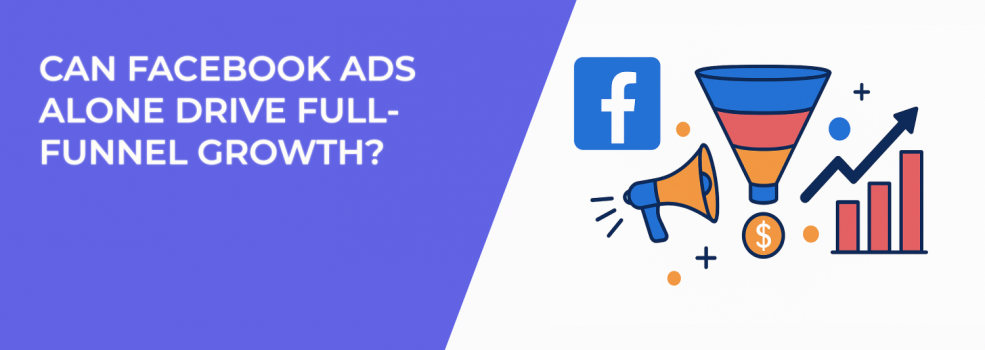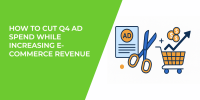If you’ve been running Facebook ads for a while, you’ve probably wondered: can Facebook really handle everything — from getting attention to making the sale and keeping customers around?
It’s a good question. Facebook (now Meta) gives advertisers a lot of powerful tools. But with higher costs, limited tracking, and changing user habits, simply boosting a post isn’t enough anymore.
You need a clear plan that guides people from first seeing your ad to actually buying — and hopefully coming back again.
So, can Facebook Ads do all of that by themselves? Let’s find out.
What Full-Funnel Growth Actually Looks Like
You can’t answer whether Facebook can support the full funnel unless you’re crystal clear on what the “full funnel” actually includes.
Full-funnel growth refers to the process of guiding potential customers through every stage of the buying journey:
-
At the top: making them aware of your brand.
-
In the middle: helping them evaluate their options and consider your offer.
-
At the bottom: converting interest into action — whether that’s a sale, signup, or lead.
-
And after the purchase: keeping the relationship alive through retention, upsells, and referrals.
These stages require different messages, creative formats, and calls-to-action. You wouldn’t talk to a complete stranger the same way you talk to a repeat customer, right? The same logic applies to your ad funnel.
Many marketers try to push everyone into a one-size-fits-all campaign. That approach burns your budget and shortens your funnel reach. Facebook can support all funnel stages — but only if you build each one intentionally.
If you're not sure how to structure this, the Facebook Ads Funnel Strategy: From Audience Identification to Conversion article breaks down the campaign types, audiences, and objectives needed for each step.
Where Facebook Ads Perform Best (and Why)
Let’s be honest: Facebook didn’t become a global ad giant by accident. The platform’s strength lies in its targeting precision and creative flexibility. If used smartly, it can help you engage audiences at every stage — but each stage has its nuances.
Top of Funnel (Awareness): Reaching the Right Strangers
Facebook is still one of the most effective platforms for brand awareness. You can run video ads, static image campaigns, carousels, or Reels — all designed to stop the scroll and introduce your brand.
At this stage, you’re not asking for a sale. You’re planting a seed.
Because Facebook has one of the largest user bases in the world, it’s ideal for reaching large groups of potential customers — even if they’ve never heard of your business before. And with tools like lookalike audiences or interest-based targeting, you’re not just throwing money into the void. You're introducing your brand to people who are statistically more likely to care.
Still, building cold audiences requires a smart approach. Facebook Ad Targeting 101: How to Reach the Right Audience covers exactly how to balance broad vs. narrow targeting and avoid wasting spend on the wrong clicks.
Where Things Get Complicated: Mid- and Bottom-Funnel
Once someone has clicked, engaged, or visited your site, it’s tempting to try to convert them instantly. But mid- and bottom-funnel campaigns aren’t just about urgency — they’re about alignment.
Middle of Funnel (Consideration): Nurture the Right People
Use this phase to retarget video viewers, landing page visitors, or Instagram engagers. But avoid hammering them with the same creative over and over. Not only does this trigger ad fatigue, it also drives costs up.
To avoid performance dips, build out segmented audiences and rotate in fresh creative every 7–10 days. If you're unsure how to get through the learning phase efficiently, How to Finish the Facebook Learning Phase Quickly offers practical steps to speed up optimization.
Bottom of Funnel (Conversion): Close the Deal (Without Overselling)
At this stage, you're reaching people who already know what you offer — maybe they’ve even added to cart. But it doesn’t mean they’re ready to buy today. This is where personalization makes all the difference.
Dynamic Product Ads (DPAs), limited-time offers, and reminders can all work well here — if you’ve warmed your audience up properly.
But if your campaigns still aren’t converting, take a moment to read Facebook Ads Not Converting: How To Fix It. It outlines common issues like mismatched CTAs, poor post-click UX, and targeting disconnects.
Can Facebook Cover the Whole Funnel Alone?
Technically, yes. You can build awareness, generate leads, drive sales, and even retarget past customers — all within Meta's ecosystem.
But depending on Facebook only comes with real limitations:
-
Attribution is limited — you're often blind to multi-touch interactions.
-
Audiences burn out fast — creative fatigue and high frequency lead to diminishing returns.
-
Your campaigns may not even deliver — many advertisers run into “Ad Set May Get Zero” issues without realizing what’s holding them back.
If you don’t expand beyond Facebook, you miss out on key touchpoints — like Google Search, email, or influencer validation — that reinforce the funnel.
Smart Ways to Use Facebook in a Full-Funnel Strategy
Facebook doesn’t have to do everything — but it can play a powerful role if you structure campaigns intentionally.
Use the Right Campaign Objectives
You wouldn’t run a conversion campaign for someone who doesn’t know you exist. Aligning goals to funnel stages is key. Learn how to choose the correct goal with Meta Ad Campaign Objectives Explained.
Build Segmented Funnels
Split your campaigns by stage:
-
Awareness: Broad targeting, video views, content-based ads.
-
Consideration: Engagement retargeting, testimonials, FAQs.
-
Conversion: Product-focused, cart retargeting, urgency-driven offers.
This structure ensures you’re not pushing the wrong message at the wrong time.

